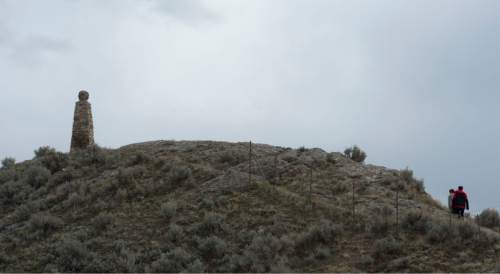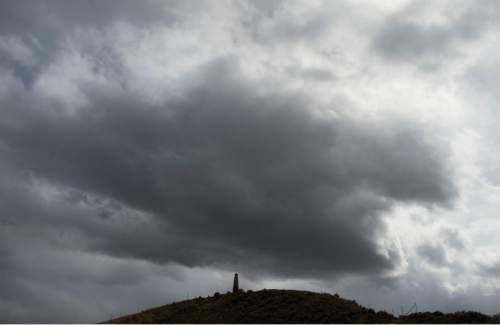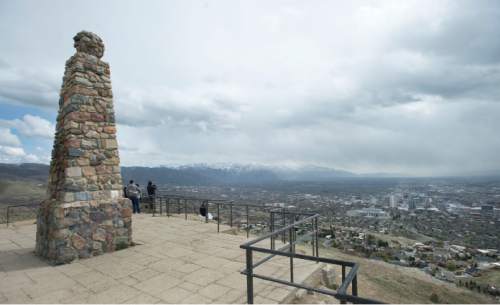This is an archived article that was published on sltrib.com in 2015, and information in the article may be outdated. It is provided only for personal research purposes and may not be reprinted.
Jutting up like a rounded brown thumb a mile north of the Utah Capitol, Ensign Peak boasts a unique claim: This humble hill once served as a Mormon temple — at least for one day and for one person.
Many of the crowds flocking to LDS General Conference this weekend will visit some of the 14 other Mormon temples in the Beehive State (with three more planned or under construction). Few may realize that the hill north of downtown Salt Lake City played host to the first LDS temple ordinance performed in Utah.
The peak has much other historical significance, too, ranging from Brigham Young proclaiming he saw it in a vision as the hill beneath which Mormon pioneers should settle to an LDS belief that the site represents fulfillment of biblical prophecy.
Ensign Peak's history as a temple is unusual because The Church of Jesus Christ of Latter-day Saints normally reserves its most sacred sacraments — including eternal marriage — for specially designed and dedicated buildings.
One of those temple ceremonies is called the endowment, a word meaning gift. The church's website says that "as part of this ordinance, we are taught about the purpose of life, the mission and atonement of Jesus Christ and Heavenly Father's plan for his children. We gain a glimpse of what it will be like to live in his presence."
Before mobs forced Mormons to flee Nauvoo, Ill., members crowded an early LDS temple there to receive the endowment before trekking westward toward Utah.
To show the importance of temples, Young designated the site for the Salt Lake Temple just days after he arrived in the Salt Lake Valley. But that iconic temple would not be completed for 46 years. Other Utah temples would be finished before that in St. George, Logan and Manti, but they still were decades away.
Meanwhile, Addison Pratt missed the opportunity to receive his endowment in Nauvoo because he was away as a missionary in the South Pacific. In 1849, he was about to leave again on a mission to the Society Islands, or French Polynesia. He and LDS leaders wanted him to receive that ordinance before he left, and Ensign Peak essentially became a temple for the purpose.
Minutes of the event — published in the book "The Development of LDS Temple Worship 1846-2000" — record that on July 21, 1849, Young, six members of the faith's Quorum of the Twelve Apostles and other general authorities met atop the hill with Pratt at 6 a.m.
Young prayed and "consecrated the spot for the present purpose of giving ... Pratt his endowment that we might have power to erect a standard that should be glorified in the eyes of all its beholders, that no unholy thing might come here, that thy servants may come here to offer up prayers and obtain the ministration of angels."
LDS historian B.H. Roberts wrote that the "action was in harmony with the instructions of the Prophet [LDS Church founder Joseph Smith] in Nauvoo when he said that these ordinances of the temple under certain circumstances might be obtained on the mountaintop, as Moses obtained them."
Devery S. Anderson, editor of "The Development of LDS Temple Worship," wrote that Pratt's endowment is the only one documented to have occurred on Ensign Peak.
Other endowments would be performed before permanent Mormon temples were up and running in the Salt Lake Valley, according to the book, including in an early Salt Lake City building called the Council House (which later burned down) and a temporary temple dubbed the Endowment House on Temple Square.
Pratt, originally a whaler from New England, served several LDS missions, including the faith's first foreign-language mission (he had learned Hawaiian as a young sailor). For a short time, he offered classes in Utah to teach Tahitian to other potential proselytizers, essentially operating the church's first language training center for missionaries.
Among other historical highlights for Ensign Peak, George A. Smith — a counselor to Young — said that Mormonism's second prophet saw the hill in a vision and was told LDS pioneers should settle beneath it, according to Dennis Wright and Rebekah Westrup, who wrote a chapter about the hill's history in "Salt Lake City: The Place Which God Prepared."
George A. Smith said Young recognized the hill when he arrived in the valley because of that vision.
Young climbed Ensign Peak two days after he arrived in the valley with other leaders and began planning the new settlement using the view from that hilltop.
Wilford Woodruff, an early apostle who later led the LDS Church, suggested while there — according to a plaque on the peak — that it was a fit place "to set up an ensign" to fulfill Isaiah 11:12.
That Bible passage proclaims, "And he shall set up an ensign for the nations, and shall assemble the outcasts of Israel, and gather together the dispersed of Judah from the four corners of the earth."
A Mormon hymn, "High on the Mountain Top," was written by Joel Johnson and inspired by Ensign Peak, along with other Isaiah prophesies saying that "the mountain of the Lord's house shall be established in the top of the mountains, and shall be exalted above the hills; and all nations shall flow unto it" in the last days (Isaiah 2:2).
Wright and Westrup wrote that the current monument and flagpole atop the hill was built in 1934, and included stones gathered from the Mormon Pioneer Trail and various LDS historical sites, including the Sacred Grove in New York (where founder Smith said he saw God).
A public trail up to the peak, with a monument garden at its base, starts off Ensign Vista Drive in Salt Lake City. Utah LDS temples and dedication dates
St. George, 1877.
Logan, 1884.
Manti, 1888.
Salt Lake, 1893.
Ogden, 1972, rededicated 2014.
Provo, 1972.
Jordan River (South Jordan), 1981.
Bountiful, 1995.
Mount Timpanogos (American Fork), 1996.
Vernal, 1997.
Monticello, 1998.
Draper, 2009.
Oquirrh Mountain (South Jordan), 2009.
Brigham City, 2012.
Payson, scheduled for June 7.
Provo City Center (formerly the Provo Tabernacle), under construction.
Cedar City, announced. —
What is the LDS endowment?
Mormons go to temples to take part in "endowment" ordinances for themselves and for people who have died. The symbolic ceremony includes ritual re-enactments of the creation, Adam and Eve's expulsion from the Garden of Eden and humankind's mortal journey and ultimate return to God's presence. In the Salt Lake and Manti temples, live actors portray these scenes. But in all other Mormon temples, the story is told through films. During the ceremony, LDS templegoers make promises to the Almighty to act, speak and think according to heaven's commands.
Sources: Encyclopedia of Mormonism, lds.org —
Peak prophecy
"And he shall set up an ensign for the nations, and shall assemble the outcasts of Israel, and gather together the dispersed of Judah from the four corners of the earth."
Isaiah 11:12















